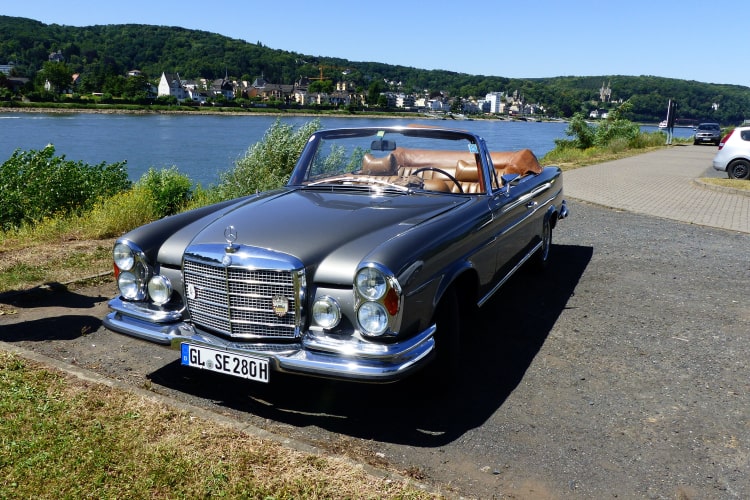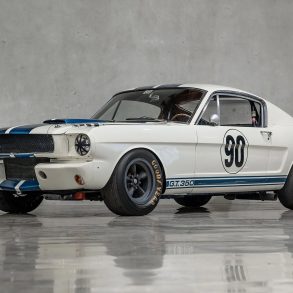Christian Kramer is an automotive expert of considerable note.
Once an auto broker, he’s since become a certificated vehicle vetter and appraiser. He can provide a full forensic and market valuation write-up on a single vehicle or an entire collection. He often does for banks that finance such things, insurance companies, and transactional and estate settlement purposes.
Chris is also a much-in-demand international Concours judge, on the judging teams, or as chief judge, of several of the world’s most significant Concours. He’s also my friend.
Since Mr. Kramer is a native of the Cologne area of Germany, when it came time for my wife and I to plan a recent visit to his city, we asked his advice on things to see and do.
We very much wanted to take a day-long boat cruise of the River Rhine, so we asked him which boat line he could recommend and from which ports or cities we should depart and arrive.
His answer was clear: “the tour boats take too long and are too slow; you’ll spend half your day grinding upriver before you see anything interesting.

Instead, I will take you!”
Gee Chris, didn’t know you owned a riverboat. Once he said his yacht of choice for our daylong tour would be his 1969 280SE 3.5 cabriolet, we became much more interested.
His plan was to pick us up on the designated morning, and cruise us – mostly top-down – about 100 miles upriver, and then back to dinner near our hotel that night. How could we say no?
Among Chris’s many talents is that he’s a noted Mercedes-Benz aficionado and expert enthusiast, with his stable of “Mercedes boats” including a 300SL Gullwing, a 300SL roadster, a 280SE 3.5 coupe restoration project, plus the Cabriolet as mentioned above. Many other three-pointed stars have come and gone over time from his real and metaphorical garages, plus several Porsches.

Why the Rhine? Simple really: The Rhine River (German: Rhein, French: Rhin, Dutch: Rijn) is 1,230 kilometers (760 mi) long, of which about 883 kilometers (549 mi) and can be used by ships. It is one of the longest rivers in Europe. Its name comes from the Celtic word “Renos” meaning raging flow.
The Rhine is an important waterway. Many goods are transported over the Rhine, and the Rhine valley is also an important wine-producing region.
The River Rhine begins at Tomasee, a lake in the canton of Graubünden in Switzerland, and runs through Switzerland, Germany, and the Netherlands.
It is the border between Switzerland and Liechtenstein and also the border between Germany and France. It runs through Basel, Bonn, Cologne, and Duisburg. It also separates the cities of Mainz and Wiesbaden.
The river runs only into one lake on its way, which is Lake Constance on the border of Switzerland, Germany, and Austria. In Germany, it also intersects the River Mosel. Like beer, wine, Mercedes-Benz, and Porsche, the River Rhine is something Germany is intensely and legitimately proud of.
It’s a magnificent and historic waterway dotted with dozens of fascinating castles, small and large villages, and lovely hillside farms and vineyards.
Naturally, we accepted Chris’s generous offer to be our captain and were ready with hats and sunscreen in hand at the agreed-upon date and time.
Kramer’s SE 3.5 Cab is just the car anyone would want; clean and straight and mechanically tight and right; a Euro-spec car with factory AC, having been resprayed only once, and far more original and maintained than “restored.”

It’s nice enough to drive and be absolutely proud of, but not so lovely or fragile that you’d be afraid to take it out on our planned 200-mile sojourn. Chris has owned it for several years and put right the things that were not upon his acquisition.
He had the paint job done so he could see what was underneath it. He felt that the original white didn’t particularly complement the virtually handbuilt convertible’s elegant styling. By having it done to his expectation, the car doesn’t appear to have ever suffered any notable accident damage nor debilitating rust.

The warm brown leather upholstery is “couch comfy” and in fine shape, showing the natural creasing of age, yet supple and still smooth. The wood is also clean and uncreased. The chrome sparkles and the car still wears its original and proper steel wheels and body-color painted hubcaps.
The original engine was shot when he acquired the car, so it’s been swapped with a slightly newer 3.5-liter V-8 of virtually identical spec to the original.

He still has the matching numbers block and could employ it in a rebuild, but the replacement engine performs so well, he doesn’t feel compelled to do that at this time. The car is beautiful in every sense of the term, but a driver, not a garage queen.
Chris picks us up at the appointed time and place, with the top closed, as the first leg of our tour will be top up on the autobahn; no need to deal with the noise and wind of the expressway. The SOHC V-8 fires on the button, idling like a well-oiled Rolex; the exhaust note a soft thrum. Chris engages the 4-speed column shifted automatic trans, and we’re away easily.
This Euro-spec motor is good for 200 horsepower, while North American versions were choked down to about 180 to meet emissions. In this day of five, six, eight, and ten-speed automatic transmissions, it was interesting to watch the tach needle hover at around 3000 pm on the highway, while all the new cars seem to dawdle along at 1600 revs in top. Not that it mattered to this engine, as 3000 rpm seemed little more than a fast idle to this superbly balanced V-8. He punches the throttle a few times, and meaningful power and smooth torque is on tap from 3-4000 revs.

And goodness, is this car comfortable. The foam in the original “orthopedically designed” seats has definitely aged to the spongy side, yet there’s still just enough support to keep thighs and lower back from aching; a restuffing someday with new foam will do these chairs well. The ride is proper gran Turismo – on the firm side of supple with adequate body motion control and confident, if not racy, cornering; remember that the 280SE’s suspension is all mechanical, with actual springs and shock absorbers, and not a computer in sight.
Once off the autobahn, we pull over to drop the top, an old-school manual operation requiring a small tool to disengage the header latches and an easy flip down and fold motion to lower the cloth top. The well-fitted tonneau cover snaps tightly over the roof. Let the sunshine in!
We steered onto the road that runs along the river and were immediately impressed with how generally quiet the car remained. Definitely with the wind in the hair, but sans the punishment of too much buffering. No flip-up “wind blocker” is offered nor needed.

Now we hear a bit more of the motor music, yet the V-8’s purr is smooth and sophisticated, authoritative instead of muscular. You wouldn’t call this car fast, but it’s at least swift and never struggles to move out. Our speed along the mighty Rhine varies from 25 or so through the various towns and villages to around 50 on the more open passages; we are in absolutely no hurry, the joy, in this case, being the drive, not any particular destination.
We stop, admire the car, have a cold drink, gaze up at the hillside castles; some still private residences, a few now converted to hotels, and others awaiting restoration and repurpose. The river itself is also a marvelous specimen of nature; at some places, it’s relatively narrow, maybe 100 yards across; at others, it widens to near lake-like proportion.
Some cities and villages along the Rhine are larger, some just enough to support the small bedroom communities surrounding them. There’s lots of farming on the hills and inclines that border both sides of the water; little of this turf is flat, and some grow food while others are planted vineyards, no matter some of the hillsides are steep and farming this land is hard, labor-intensive work, but it’s all beautiful.

Among the more famous sights on our route is the castle Lorelei. The tales of a woman named Lorelei in Germany’s Rhine River Valley date back several centuries. According to legend, many boats lie at the bottom of the Rhine River because of her.
As the story goes, in the narrowest and deepest point of the Rhine, there once was a woman of such beauty and a musical singing voice that she would cause sailors to wreck their ships as they sailed the dangerous currents along the river’s jagged shorelines. Was it her long, blonde hair? Were sailors distracted because she lay sunbathing along the river’s edge? Or was Lorelei a siren who intentionally lured bewitched sailors to their doom by singing the loveliest song they had ever heard? Each version of the legend has earned a place in Rhine Valley lore.
A woman beautiful enough to cause shipwrecks? Today, besides the telling and retelling of these mystic stories, all that is left of the legend herself is a statue sitting at the end of a narrow arm of land that juts out into the Rhine. It’s doubtful that the many river cruise ships that ply vacationers up and down the Rhine are at risk due to the legend of Lorelei.


One fun break along the way was a brief ferry ride across the river to drive home on the opposite side of the water and see everything from a different view. The ferry operation is very efficient, loading up a half dozen cars, plus walk-ons, cyclists, and motorcyclists. The fee is only a few Euros per vehicle, and the boat crosses the lake in about ten minutes. Plus, of course, the view of the water from on the water is compelling.
Chris’s SE Cab performed flawlessly all day, the perfect land yacht for our River Rhine cruise; we felt comfortable and refreshed at day’s end. She’s got the speed when needed, yet she was happy to amble mile after mile. Every inch of this car smacks of handbuilt quality; the chrome plating on real metal, not plastic as on today’s moderns. The interior wood trim is thick, rich, and warm. The leather smells old and wonderful, and every inch of the car speaks of luxury, comfort, and style. Just 3270 of this now rare and exceedingly valuable W111 platformed V-8 engined cabriolet models were built for worldwide consumption from 1969-1971.
Some have disappeared due to accident damage and the specter of the tinworm, so good ones are hard to find, highly sought after, and expensive. It truly was Mercedes-Benz’s last coachbuilt car, and all of that care and handwork it took to build it is evident in everything you see and touch.
A landmark classic when new, and more so one today. And the best way possible to cruise alongside the mighty river Rhine. Thanks Chris.











Thanks for the story, I have a silver-black 1970 3.5 cabriolet that I’m considering selling into the European marketplace, if chris would be interested in acting as my “agent” for a sale, I’d welcome a conversation with him, it’s just come out of a 3500 hour full rotisserie restoration, best regards, gary c Shapiro Toronto. Canada
Sorry Matt, I forgot to mention that there is a video of my cabriolet on my website, so chris could actually see it, my site is autovaultcanada.com I’ve owned Canada’s largest collector car storage facility for the last 18 years, be well and safe, again. Regards, gary c Shapiro, Toronto
I an so glad tha I retained for some 40+ years, a 1971 280 se 3.5 coupe rom the time I had an MB dealership.